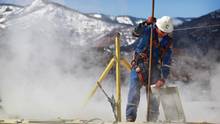The slide flashed up, on two screens, in a hall of over a thousand conference attendees. No one gasped, even though oil prices were already showing signs of erosion a couple of weeks ago. The data seemed matter-of-fact to an oil and gas crowd that has been desensitized to drilling frenzies and gusher wells that are enough to make John Wayne smile in his grave.
Yet there it was, a remarkable stat buried among many that should have made everyone at the Dallas Convention Centre take a deep breath. According to the source, just one oil play in the Texas Midland Basin, the Spraberry/Wolfcap shale, may have a total recoverable resource of up to 50 billion barrels using new tight-oil extraction technologies. This revelation presents us all with an arresting number, if indeed that much oil is producible from a region already famous for its hydrocarbon potential. For one thing, supplementary data from the U.S. Energy Information Agency shows that only 1.3 billion barrels have been produced from the legacy region since its original discovery in 1949. So tapping into the multizone Spraberry/Wolfcap with horizontal drilling and hydraulic fracturing processes is a like finding a virgin oil field – a very big one at that.
There was no gasp when the 50-billion-barrel figure was shown, likely because of the lack of historical context.
The history need not go back too far. Back in only 2006, I wrote in my book A Thousand Barrels a Second that the amount of new recoverable reserves being found annually by the global oil industry had dwindled to around 10 billion barrels – a disturbingly small number relative to world oil consumption that was then pushing through 30 billion barrels per year. This three-to-one ratio of consumption versus discovery was a fundamental reason why oil prices were escalating through the roof by mid-decade, and why either the demand side, or the supply side, or both, had to yield in what I termed a “Breaking Point.” Following classic economic theory, both production and consumption in North America did break multidecade trends pursuant to the high oil price, the highest price ever recorded in real-dollar terms.
Demand side changes are not to be ignored, but the most spectacularly nascent trend is the potential recovery of vast quantities of oil from shale and tight rocks using ever-improving drilling and completion techniques. Consider that the peak year for discovering oil reserves was 1960. In that boom era the global industry added about 60 billion barrels to inventory in the ground. But that was a one-off peak year – annual additions between 1955 and 1980 were, on average, around 40 billion barrels.
Discoveries were going downhill through most of the 80’s and 90’s, until new offshore drilling technologies momentarily reversed the trend by opening up the deep waters of the Gulf of Mexico, West Africa and Brazil. A fleeting peak of exploratory success in 2000 added a mere 20 billion barrels.
Today’s North American oil boom, if sustainable, takes us back to the discovery atmosphere of the 1950s and 60s. The potential is hardly limited to the Spraberry/Wolfcamp. North Dakota’s headlining Bakken play is conjectured to contain over 10 billion barrels, while the Eagle Ford shale could be up to 25 billion. If oil follows the path of natural gas, there are likely to be several more “sweet” mega-plays, including prolific ones germinating in Canada that could collectively stack up to be the most significant era of reserve additions in the 155-year history of the industry.
Yet the best context for the size of the Spraberry/Wolfcap, and the tight oil revolution as a whole, may be the Canadian oil sands. At the peak of the peak oil worries in 2007, this mother lode of heavy oil was considered to be the deus ex machina of the free world’s oil supply woes. Investment into innovative, large-scale extraction processes led to the recognition that 170 billion barrels of oil could be recovered from the northern Alberta wilderness. At that time, the oil sands were second in size to what was under the feet of the Saudis, and 17 times the size of the biggest offshore find of the day. The vast Canadian oil sands are still a formidable source of supply, but the tight oil revolution is marginalizing its once awesome size to something that’s merely big among others.
All this is disquieting to oil producers everywhere, especially with retreating Chinese demand growth. Who should be most concerned about this remarkable renaissance? The Saudis? The oil sands producers? Other exporters to the U.S.? Or maybe even the American producers themselves – many of them suggest that the average break-even cost for monetizing light tight oil reserves is notionally, though debatably, around $80 (U.S.) per barrel for West Texas intermediate.
The jury is out for determining winners and losers. The ability to turn conjectured oil reserves under the ground into producing wells on the surface is dominantly a function of price. Recent weakness in commodities suggests that the oil price at which the world’s oil reserves stop turning into production may be soon tested. Then we’ll really know how much oil is available, and which producers have the most to be worried about.
Today’s oil discovery sizes not seen since 1960






















Laissez un commentaire Votre adresse courriel ne sera pas publiée.
Veuillez vous connecter afin de laisser un commentaire.
Aucun commentaire trouvé